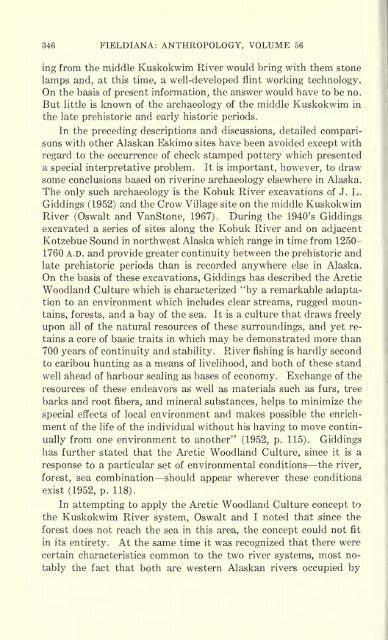Tikchik village: a nineteenth century riverine community in ... - Cluster
Tikchik village: a nineteenth century riverine community in ... - Cluster
Tikchik village: a nineteenth century riverine community in ... - Cluster
- No tags were found...
You also want an ePaper? Increase the reach of your titles
YUMPU automatically turns print PDFs into web optimized ePapers that Google loves.
346 FIELDIANA: ANTHROPOLOGY, VOLUME 56<strong>in</strong>g from the middle Kuskokwim River would br<strong>in</strong>g with them stonelamps and, at this time, a well-developed fl<strong>in</strong>t work<strong>in</strong>g technology.On the basis of present <strong>in</strong>formation, the answer would have to be no.But little is known of the archaeology of the middle Kuskokwim <strong>in</strong>the late prehistoric and early historic periods.In the preced<strong>in</strong>g descriptions and discussions, detailed comparisonswith other Alaskan Eskimo sites have been avoided except withregard to the occurrence of check stamped pottery which presenteda special <strong>in</strong>terpretative problem. It is important, however, to drawsome conclusions based on <strong>river<strong>in</strong>e</strong> archaeology elsewhere <strong>in</strong> Alaska.The only such archaeology is the Kobuk River excavations of J. L.Gidd<strong>in</strong>gs (1952) and the Crow Village site on the middle KuskokwimRiver (Oswalt and VanStone, 1967). Dur<strong>in</strong>g the 1940's Gidd<strong>in</strong>gsexcavated a series of sites along the Kobuk River and on adjacentKotzebue Sound <strong>in</strong> northwest Alaska which range <strong>in</strong> time from 1250-1760 A.D. and provide greater cont<strong>in</strong>uity between the prehistoric andlate prehistoric periods than is recorded anywhere else <strong>in</strong> Alaska.On the basis of these excavations, Gidd<strong>in</strong>gs has described the ArcticWoodland Culture which is characterized "by a remarkable adaptationto an environment which <strong>in</strong>cludes clear streams, rugged mounta<strong>in</strong>s,forests, and a bay of the sea. It is a culture that draws freelyupon all of the natural resources of these surround<strong>in</strong>gs, and yet reta<strong>in</strong>sa core of basic traits <strong>in</strong> which may be demonstrated more than700 years of cont<strong>in</strong>uity and stability. River fish<strong>in</strong>g is hardly secondto caribou hunt<strong>in</strong>g as a means of livelihood, and both of these standwell ahead of harbour seal<strong>in</strong>g as bases of economy. Exchange of theresources of these endeavors as well as materials such as furs, treebarks and root fibers, and m<strong>in</strong>eral substances, helps to m<strong>in</strong>imize thespecial effects of local environment and makes possible the enrichmentof the life of the <strong>in</strong>dividual without his hav<strong>in</strong>g to move cont<strong>in</strong>uallyfrom one environment to another" (1952, p. 115). Gidd<strong>in</strong>gshas further stated that the Arctic Woodland Culture, s<strong>in</strong>ce it is aresponse to a particular set of environmental conditions^— the river,forest, sea comb<strong>in</strong>ation— should appear wherever these conditionsexist (1952, p. 118).In attempt<strong>in</strong>g to apply the Arctic Woodland Culture concept tothe Kuskokwim River system, Oswalt and Inoted that s<strong>in</strong>ce theforest does not reach the sea <strong>in</strong> this area, the concept could not fit<strong>in</strong> its entirety. At the same time it was recognized that there werecerta<strong>in</strong> characteristics common to the two river systems, most notablythe fact that both are western Alaskan rivers occupied by






![La musa galante [microform] - University Library](https://img.yumpu.com/50760818/1/190x222/la-musa-galante-microform-university-library.jpg?quality=85)










